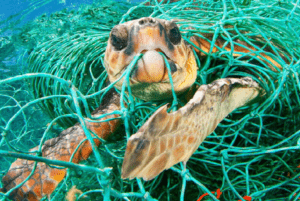
Introduction:
One of the most important environmental issues of our time is plastic pollution. Sometimes we need to take a step back and think about how the decisions we make every day impact the planet.
The impacts of plastic pollution and the alarming quantity of waste generated are interrelated as the world’s population grows exponentially.
Currently, there are about 150 million metric tons of plastic in our oceans and we continue to add 8 million metric tons more each year.
The impacts of plastic pollution are observed in almost every corner of the ocean, including the remote Arctic seas and the deep sea. This staggering amount of plastic also impacts wildlife in the oceans.
For example, sea turtles mistakenly eat plastic nets thinking they are jellyfish. Seabirds, whales, dolphins, and other marine animals frequently turn up dead with stomachs full of plastic or trapped in abandoned plastic fishing nets.
If current trends continue, the amount of plastic garbage in our landfills or damaging the environment by 2050, will be close to 80 million blue whales’ worth, or about 12 billion tonnes.
This article, “Startling Impacts of Plastic Waste Pollution: Causes, Effects and Solution”, explores plastic pollution in great detail.
I. What causes plastic pollution?
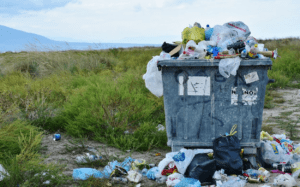
Plastic pollution is caused by a combination of factors, including:
a) Excessive use and production of plastic:
The overuse and production of plastic products, particularly single-use plastics, contribute significantly to plastic pollution.
The demand for cheap and convenient plastic items has led to their widespread use and disposal, resulting in massive amounts of plastic waste.
b) Improper waste management:
Inadequate waste management systems, such as poor recycling infrastructure and improper disposal of plastic waste, play a major role in plastic pollution. When plastic waste is not effectively managed, it can end up in landfills, rivers, lakes, and oceans, causing environmental damage.
c) Lack of awareness and education:
Many people are not aware of the detrimental effects of plastic pollution or the importance of responsible plastic use and disposal.
Insufficient education and awareness programs contribute to the continued use and improper handling of plastic, exacerbating the problem.
d) Plastic in fishing and maritime activities:
Fishing gear, including nets and ropes, is often made of plastic. When these fishing materials are lost, abandoned, or improperly disposed of, they contribute to marine plastic pollution.
e) Natural disasters and weather conditions:
Natural disasters, such as floods and hurricanes, can transport plastic waste from land to water bodies. Wind and rain can carry lightweight plastic items, like bags and bottles, into rivers and oceans, further exacerbating pollution.
II. Why is plastic pollution a Problem?
Plastic pollution is a significant problem due to the following reasons:
a) Environmental Impact:
Plastic pollution harms ecosystems, disrupts the balance of natural habitats and threatens biodiversity. Wildlife, including marine animals, birds, and land animals, can suffer from ingestion or entanglement in plastic, leading to injury or death.
b) Health Concerns:
Plastics contain toxic additives and can accumulate harmful substances in the environment.
Microplastics and their associated chemicals can enter the food chain, posing potential risks to human health through the consumption of contaminated seafood and water.
c) Longevity:
Plastics are durable and do not easily break down in the environment. They persist for hundreds of years, accumulating in landfills, oceans, and other natural habitats.
This long-lasting nature exacerbates the problem, as the accumulated plastic waste continues to cause harm over an extended period.
d) Resource Depletion:
The production of plastic requires fossil fuels, contributing to resource depletion and carbon emissions.
Additionally, improper disposal and inefficient recycling of plastic waste result in the loss of valuable resources that could be reused or recycled.
e) Economic Implications:
Plastic pollution imposes economic costs on societies. These include expenses related to waste management, cleaning up polluted areas, and damage to industries such as tourism and fisheries, which rely on clean environments.
III. Types of Plastic Pollution:
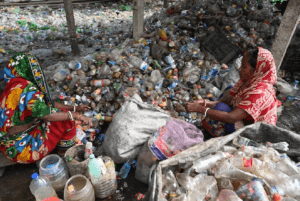
a) Macroplastics:
These are large plastic items, such as bags, bottles, packaging materials, and fishing nets, that can be easily visible and cause harm to wildlife through entanglement or ingestion.
b) Microplastics:
These are tiny plastic particles, less than 5 millimeters in size. They can be either primary microplastics, such as microbeads used in personal care products, or secondary microplastics, which result from the breakdown of larger plastic items over time.
c) Microfibers: These are small synthetic fibers released from textiles like clothing during washing. They are a type of microplastic and contribute significantly to plastic pollution in water bodies.
d) Plastic Film: Thin plastic sheets used for packaging, plastic bags, and plastic wrap. They can easily become litter and pose a threat to wildlife.
e) Low-density polyethylene (LDPE):
It is used to produce bags, packaging film, buckets, CDs, etc. polyvinyl chloride (PVC). This plastic is used to produce hoses, wallpapers, floor coverings, etc.
It is one of the most harmful types of plastic since it releases toxic substances, which negatively affect human health as well.
f) Polystyrene (PS):
It is used to produce food packaging, electrical equipment parts, etc. Along with PVC, it is one of the most harmful types of plastic. Packaging materials made of polystyrene emit a toxic substance – styrene.
The release of this toxic substance is especially active when heated. Therefore, such packaging cannot be used for packaging hot dishes, and such packaging should not be subjected to heat treatment.
g) Polypropylene (PP):
This type of plastic is used in the manufacture of furniture, in the automotive industry, in the manufacture of medical devices, etc. Among plastics, polypropylene is the safest and most versatile material.
It can be used when packing products, both cold and hot dishes. polyurethane (PUR), sponges for dishes, mattresses, etc. are made from it.
h) polyethylene terephthalate (PET). Used in the manufacture of cars, implants, etc.
IV. Plastic in numbers
50% of all plastics produced each year are single-use items.
A million seabirds, marine animals, and turtles perish each year as a result of marine plastic pollution.
40% of all plastic produced is used to make single-use containers that are thrown away after use.
By 2050, there may be more plastic in the ocean than there are fish.
Eight million tons of plastic are thought to enter the oceans annually.
V. Plastic Waste Problem in the World
One of the most popular and at the same time one of the most environmentally harmful types of packaging today is plastic. Most plastic products are used once and are not recycled.
Environmental pollution with plastic waste has become a global problem for mankind. The plastic waste problem in the world is significant and has several key aspects:
a) Production and Consumption:
The production of plastic has increased dramatically over the years, and the consumption of single-use plastics has become widespread. This has led to a massive volume of plastic waste being generated globally.
b) Improper Waste Management:
Many regions lack effective waste management systems, leading to inadequate collection, recycling, and disposal of plastic waste. Improperly managed waste often ends up in landfills, oceans, or gets incinerated, causing environmental pollution.
c) Plastic packaging:
The packaging industry is a major contributor to plastic waste. Excessive use of plastic packaging, especially for single-use products, generates significant amounts of waste that are difficult to manage.
d) Lack of recycling infrastructure:
Insufficient recycling facilities and infrastructure pose challenges to proper plastic waste management. Many types of plastic are not easily recyclable, and recycling rates vary widely across different regions.
e) Plastic Pollution in Oceans: Plastic waste often finds its way into water bodies, causing marine pollution. It affects marine life through ingestion, entanglement, and habitat destruction.
VI. Causes of Plastic Pollution
A. Plain Old Trash
Plastic pollution is not only caused by obvious sources but also by unexpected ones. It is important to recognize that plain old trash, including everyday items we use, contributes significantly to plastic pollution.
Items like milk cartons lined with plastic, ubiquitous water bottles, and products containing tiny plastic beads all add to the problem.
When these items are thrown away or end up in water systems, they have the potential to release toxic pollutants into the environment, causing harm to ecosystems.
Trash dumps and landfills exacerbate the issue, as they allow plastic pollutants to enter the ground and impact wildlife and groundwater for extended periods.
Even seemingly harmless items can have detrimental effects when not disposed of properly, leading to the accumulation of plastic waste and pollution.
B. Overuse and Overproduction of Plastic
The overuse and overproduction of plastic are major factors contributing to plastic pollution. Plastic has become widely available and is often used excessively due to its affordability and durability.
With rapid urbanization and population growth, the demand for cheap plastics has increased. Plastic is utilized in various ways, including packaging materials, bottles, containers, straws, and carry bags.
The low cost of plastic has fostered a disposable mentality, where items are not valued for their long-term use but rather discarded after a single use.
This disposable mindset results in a substantial amount of plastic waste that lingers in the environment.
According to the Environmental Protection Agency (EPA), every piece of plastic ever produced and sent to landfills or dumped in the environment still exists.
This overreliance on plastic as a disposable material contributes significantly to plastic pollution.
C. Inadequate Waste Management
Improper disposal practices and the lack of recycling infrastructure are two key factors contributing to inadequate waste management, which in turn leads to plastic pollution. Here are some details about these causes:
(1) Improper Disposal Practices:
Improper disposal of plastic waste significantly contributes to plastic pollution. Many individuals, communities, and even industries do not follow proper waste disposal practices, leading to the accumulation of plastic in the environment.
Some common improper disposal practices include:
a) Littering:
Careless disposal of plastic waste by throwing it on the streets, in parks, or other public spaces is a major issue.
Plastic waste that ends up in landfills poses a threat to the environment. When plastic is dumped in landfills, it can release harmful chemicals that contaminate the soil and groundwater.
c) Open burning:
In some regions, plastic waste is burned openly as a means of disposal. This practice releases toxic pollutants into the air, contributing to air pollution and posing health risks to humans and animals.
(2) Lack of Recycling Infrastructure:
Insufficient recycling infrastructure exacerbates the problem of plastic pollution. Recycling plays a crucial role in reducing the amount of plastic waste that ends up in landfills or natural environments.
However, inadequate recycling facilities and systems hinder the effective management of plastic waste. Some reasons for the lack of recycling infrastructure include:
a) Limited Recycling Facilities:
Many areas lack proper recycling facilities, making it challenging for people to dispose of their plastic waste responsibly.
In some cases, recycling facilities may be available, but they may have limited capacity or may not accept certain types of plastic.
b) Inadequate collection systems:
Collection systems for plastic waste, such as recycling bins or designated pickup services, may be insufficient or non-existent in certain areas. This leads to a lack of segregation and proper disposal of plastic waste.
c) Economic viability:
Recycling plastic can be costly, and the economic viability of recycling may be a challenge in some regions. Without proper incentives or financial support, establishing and maintaining recycling infrastructure becomes difficult.
Addressing inadequate waste management and mitigating plastic pollution require collective efforts from individuals, communities, governments, and industries.
Implementing proper waste disposal practices, promoting recycling awareness and education, and investing in recycling infrastructure are crucial steps toward reducing plastic pollution and creating a more sustainable future.
d) Plastic in the Fishing Industry:
The fishing industry contributes to plastic pollution through various means. Fishing gear, such as nets, lines, and traps, is often made of plastic. These items, when lost or abandoned, continue to pose a threat to marine life.
This phenomenon is known as “ghost fishing,” where abandoned fishing gear continues to trap and entangle marine animals, leading to their injury or death.
Large-scale trolling operations that utilize plastic nets contribute to the problem. These nets can break or get lost, ultimately becoming marine debris.
The prolonged exposure of these nets to water allows them to release toxins and further contribute to plastic pollution in the oceans.
e) Natural Factors and Plastic Pollution:
Although human activities are the primary cause of plastic pollution, natural factors also play a role in its spread.
Winds and rain can carry plastic waste, especially lightweight items, into sewers, streams, rivers, and eventually the oceans. Natural disasters like floods can also contribute to the distribution of plastic waste.
VII. Effects of Plastic Pollution
A. Impact on Marine Life:
Plastic pollution has severe consequences for marine life, leading to the following effects:
a) Ingestion and entanglement of marine animals:
Marine animals often mistake plastic debris for food, especially smaller plastic particles, and microplastics.
Sea turtles, whales, seabirds, and fish may ingest plastic items, such as bags, bottles, and fragments, which can cause internal injuries, blockages, and even death.
Additionally, marine animals can become entangled in discarded fishing nets, plastic ropes, and other debris, leading to injuries, suffocation, or drowning.
b) Disruption of marine ecosystems and food chains:
Plastic pollution can disrupt marine ecosystems and food chains. When marine organisms ingest plastic, it can accumulate and biomagnify through the food chain.
Predatory species, including larger fish and marine mammals, can accumulate high levels of plastic toxins, which can have detrimental effects on their health and reproductive abilities.
This disruption can have cascading effects on the entire ecosystem, impacting the balance and biodiversity of marine habitats.
B. Human Health Risks:
Plastic pollution also poses risks to human health, primarily through the following mechanisms:
a) Microplastics in the food chain and their implications:
Microplastics, small plastic particles less than 5 millimeters in size, are present in various sources of food and water.
Seafood, especially shellfish, and fish, can contain microplastics that have been ingested by marine organisms. When humans consume these contaminated seafood, they may unknowingly ingest microplastics, which can have potential health implications.
b) Potential health effects on humans:
The long-term health effects of microplastic ingestion are still being studied, but there is growing concern about their impact on human health.
Microplastics can potentially transfer toxic chemicals and additives used in plastic manufacturing to humans.
These chemicals, such as bisphenol A (BPA) and phthalates, have been associated with endocrine disruption, reproductive issues, developmental problems, and other adverse health effects.
C. Environmental Consequences:
Plastic pollution has severe environmental consequences, affecting land, water, and air. Here are the effects of plastic waste on terrestrial ecosystems and wildlife:
a) Land Pollution:
Plastic waste that is improperly disposed of ends up in landfills or as litter in natural environments. These polymers break down into smaller particles known as microplastics over time.
These microplastics contaminate the soil, affecting the quality and fertility of the land. Plastic debris can also get entangled in vegetation, hindering the growth and survival of plants.
Animals that ingest plastic litter may suffer from intestinal blockages or other health issues.
b) Water pollution:
Plastic waste often finds its way into water bodies such as rivers, lakes, and oceans. Wind or water currents can carry plastic items and cause them to accumulate in waterways.
This pollution poses a threat to aquatic ecosystems, as animals mistakenly consume plastic pieces or become entangled in larger plastic debris.
Marine creatures like turtles, seabirds, and fish can suffer from ingestion, suffocation, or entanglement, leading to injuries, reproductive issues, or even death.
c) Air pollution:
Although not as prominent as land and water pollution, plastic waste can contribute to air pollution when it is burned.
Burning plastics releases toxic pollutants into the air, including dioxins and furans, which are harmful to human health and the environment.
In areas where open burning of plastic waste occurs, the surrounding air quality deteriorates, posing risks to both humans and wildlife.
d) Disruption of Ecosystems:
Plastic pollution disrupts terrestrial ecosystems by altering natural processes. Microplastics can affect the soil’s ability to absorb water and nutrients, potentially impacting plant growth and the overall balance of the ecosystem.
The accumulation of plastic waste in ecosystems can also disrupt the food chain, as animals may mistake plastic for food or consume prey contaminated with plastic particles.
This disruption can have far-reaching effects on biodiversity and ecosystem stability.
e) Habitat destruction:
Plastic pollution can lead to habitat destruction for various wildlife species. When plastic waste accumulates in natural habitats such as forests, wetlands, or grasslands, it can degrade the quality of these habitats.
Plastic debris can block waterways, impede the movement of animals, and alter the physical characteristics of the environment, making it unsuitable for many species.
VIII. Incredible Solutions to Plastic Pollution

A. Reducing Plastic Consumption
a) Promoting the use of reusable alternatives:
One effective solution to plastic pollution is to promote the use of reusable alternatives to single-use plastic items.
Encouraging individuals to carry reusable bags, water bottles, and coffee cups can significantly reduce the amount of plastic waste generated.
By adopting these reusable alternatives, we can minimize the demand for single-use plastics and prevent them from entering the environment.
b) Minimizing single-use plastics in daily life:
Another crucial step in reducing plastic consumption is to minimize the use of single-use plastics in our daily lives.
This includes avoiding plastic straws, cutlery, and disposable packaging whenever possible.
Choosing eco-friendly options such as biodegradable or compostable alternatives can also make a significant difference.
By making conscious choices to reduce our reliance on single-use plastics, we can contribute to a cleaner environment.
B. Improving Waste Management
a) Enhancing recycling initiatives and infrastructure:
An important solution to plastic pollution is improving recycling initiatives and infrastructure.
Governments, communities, and businesses should invest in comprehensive recycling programs that accept a wide range of plastic materials.
b ) Proper waste segregation and collection systems
can ensure that plastics are effectively recycled rather than ending up in landfills or oceans.
Increasing access to recycling facilities and raising awareness about recycling practices are also crucial in promoting responsible plastic waste management.
c) Raising awareness of responsible waste management practices:
Education and awareness play a vital role in addressing plastic pollution. By raising public awareness about responsible waste management practices, we can encourage individuals to properly dispose of their plastic waste.
Promoting the importance of recycling, reducing littering, and encouraging responsible consumption habits can help instill a sense of environmental responsibility in communities.
Additionally, educational campaigns and initiatives can inform people about the impacts of plastic pollution on ecosystems and human health.
C. Innovation and Technology
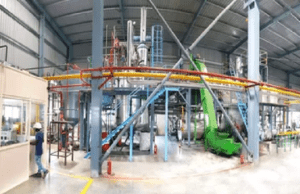
Innovation and technology play a crucial role in finding solutions to plastic pollution.
Here are some key aspects related to innovation and technology in addressing this issue:
Exploring Biodegradable and Compostable Alternatives:
One promising approach is the development of biodegradable and compostable alternatives to conventional plastic products.
Researchers and innovators are working on creating materials that can mimic the functionality of plastic but are designed to break down naturally over time.
These alternatives are often made from renewable resources like plant-based materials, which reduces their environmental impact.
Bioplastics, for example, are a type of plastic derived from renewable sources such as cornstarch or sugarcane.
They offer a potential solution by reducing the reliance on fossil fuels and minimizing the persistence of plastic waste in the environment.
Advances in Recycling Technology:
Technological advancements are enhancing recycling capabilities and improving the efficiency of plastic waste management.
Traditional recycling methods often face challenges due to the complexity of plastic waste streams and the presence of different types of plastics.
However, innovative recycling technologies are emerging to tackle these issues. For instance, chemical recycling processes, such as depolymerization and pyrolysis, can break down plastic waste into its basic building blocks, allowing them to be used as feedstock for the production of new plastics.
These technologies offer the potential to recycle a broader range of plastics and reduce the amount of plastic sent to landfills or incineration.
Circular Economy Approaches:
The concept of a circular economy aims to minimize waste and keep materials in a continuous loop of use, rather than the traditional linear “take-make-dispose” model.
In the context of plastic pollution, this involves designing products for reusability, recyclability, and recovery.
Innovations in packaging design, such as creating refillable containers or developing packaging made from recycled materials, contribute to reducing plastic waste.
Additionally, initiatives promoting extended producer responsibility (EPR) encourage manufacturers to take responsibility for the entire lifecycle of their products, including their disposal and recycling.
D. Plastic: zero waste
Plastic zero waste refers to the goal of eliminating or minimizing the production, use, and disposal of plastic in order to achieve a waste-free society.
It involves adopting sustainable practices and alternative materials to reduce plastic consumption and waste generation.
a) The concept of plastic zero waste:
This focuses on the principles of the circular economy, where resources are used efficiently and waste is minimized through recycling, reusing, and reducing.
It promotes the use of reusable products, such as cloth bags and stainless steel containers, instead of single-use plastics.
Additionally, it encourages the development and adoption of eco-friendly packaging materials and alternative solutions to plastic products.
b) Plastic zero-waste initiatives
involve individuals, businesses, and governments working together to implement sustainable practices, improve recycling infrastructure, and raise awareness about the environmental impacts of plastic pollution.
By transitioning to a plastic-zero waste approach, the goal is to reduce the amount of plastic waste entering landfills, water bodies, and ecosystems, thus mitigating the harmful effects of plastic pollution.
c) Waste Management Technologies:
Efficient waste management systems are critical for preventing plastic pollution. Technology can aid in the development of improved waste collection, sorting, and recycling infrastructure.
Automated sorting technologies, such as optical sorting machines and AI-powered algorithms, can enhance the efficiency and accuracy of plastic waste separation at recycling facilities.
Additionally, the implementation of smart waste management systems, including IoT-based sensors and data analytics, can optimize waste collection routes and improve overall resource allocation. Thus, innovation and technology offer promising avenues for addressing plastic pollution.
Exploring biodegradable and compostable alternatives, advancing recycling technologies, adopting circular economy approaches, and improving waste management systems can collectively contribute to reducing the environmental impact of plastic and moving towards a more sustainable future.
E. Government Policies and International Cooperation
There is growing global awareness and concern about plastic pollution, leading to efforts to tackle the problem.
Governments, businesses, and individuals are taking steps to reduce plastic waste, promote recycling, and develop innovative solutions.
a) Importance of legislative measures to combat plastic pollution:
Government policies and regulations play a crucial role in addressing plastic pollution. Governments should implement and enforce legislation that promotes sustainable practices, such as plastic bag bans, extended producer responsibility programs, and plastic waste reduction targets.
By creating a supportive legal framework, governments can incentivize businesses and individuals to adopt environmentally friendly practices and reduce plastic consumption.
b) Collaborative efforts for a global impact:
Plastic pollution is a global issue that requires international cooperation and collaboration. Governments, organizations, and individuals should work together to share knowledge, best practices, and resources.
Collaborative efforts can involve initiatives such as international agreements to reduce plastic waste, joint research projects, and the sharing of successful waste management strategies.
By fostering global cooperation, we can amplify our impact and achieve significant progress in combating plastic pollution worldwide.
By implementing these incredible solutions to plastic pollution, we can make a substantial positive impact on the environment, safeguard ecosystems, and promote a sustainable future for generations to come.
IX. What is the future of plastic pollution?
The future of plastic pollution depends on the actions we take today to address the issue. If we continue with business-as-usual practices, the problem of plastic pollution is likely to worsen, causing severe consequences for the environment and human health.
The future of plastic pollution could involve:
a) Reduction in single-use plastics:
Many countries and businesses are implementing bans or restrictions on single-use plastics, such as plastic bags, straws, and disposable cutlery.
This shift aims to reduce the consumption and disposal of these items, thereby reducing plastic pollution.
b) Increased recycling and circular economy practices:
There is a growing emphasis on improving recycling infrastructure and promoting the circular economy.
This involves designing products for recyclability, increasing recycling rates, and developing markets for recycled plastics.
c) Development of alternative materials:
Research and innovation are focused on finding alternative materials to replace conventional plastics.
Biodegradable plastics, plant-based materials, and compostable packaging are being explored as potential alternatives to reduce the environmental impacts of plastic pollution.
d) Public awareness and education:
Awareness campaigns and educational programs play a crucial role in changing consumer behavior and promoting responsible plastic use.
Increasing public awareness about the impacts of plastic pollution can drive individual actions and collective efforts to reduce plastic waste.
While the future of plastic pollution still poses challenges, concerted efforts and proactive measures can lead to a more sustainable and plastic-conscious society.
By adopting a comprehensive approach that combines reduction, recycling, and innovation, we can mitigate the negative effects of plastic pollution and work towards a cleaner and healthier environment.
Conclusion:
The impacts of plastic pollution range from improper disposal and mismanagement of plastic waste to the use of single-use plastics and fishing nets. These factors contribute to the pollution of oceans, rivers, and landfills, leading to a wide array of negative consequences.
The effects of plastic pollution are far-reaching and include harm to human health. This is through the consumption of contaminated seafood and water, disruption of the food chain, groundwater pollution, land litter, air pollution from burning plastic, harm to animals, and the release of toxic chemicals.
To address this crisis, individuals, businesses, and governments must take action. By adopting simple habits like using reusable bags and containers, reducing plastic consumption, and promoting recycling, we can significantly reduce plastic waste.
Businesses should explore alternative packaging options and educate customers about sustainable choices.
Governments play a vital role in implementing policies and regulations that promote plastic waste reduction and encourage the use of environmentally friendly materials.
It is imperative that we collectively tackle plastic pollution to safeguard our ecosystems, protect wildlife, and ensure a healthier future for ourselves and generations to come.
Let us all take responsibility and actively participate in finding and implementing solutions to this global problem.
Together, we can make a significant difference and create a more sustainable and plastic-free alternative, so the world.
FAQs:
What are the main causes of plastic pollution?
The main causes of plastic pollution include plain old trash, overuse of plastic products, fishing nets, and natural causes like wind and floods.
Plastic items, such as bottles, packaging materials, and bags, contribute significantly to the pollution problem.
How does plastic pollution affect marine life?
Plastic pollution has severe effects on marine life. Marine animals can mistake plastic for food, leading to ingestion and choking hazards.
Plastic debris can also entangle marine animals, causing injuries and hindering their mobility. The chemicals present in plastic can disrupt the reproductive and hormonal systems of marine organisms.
What are the health effects resulting from plastic pollution?
Plastic pollution poses health risks to both humans and animals. Microplastics, as they break down, contaminate the food chain and end up in seafood consumed by humans, potentially causing health issues.
Chemicals leaching from plastics can also affect human health, causing respiratory problems, hormonal imbalances, and other illnesses.
How can individuals reduce their plastic consumption?
Individuals can reduce their plastic consumption by adopting practices such as using reusable bags, bottles, and containers, avoiding single-use plastics, recycling properly, and supporting businesses that offer eco-friendly alternatives.
Making conscious choices and opting for sustainable alternatives can make a significant difference in reducing plastic waste.
What innovative solutions are being developed to tackle plastic pollution?
Many innovative solutions are being developed to tackle plastic pollution.
These include developing biodegradable plastics, promoting advanced recycling technologies, implementing stricter waste management systems, and supporting initiatives for plastic waste cleanup and recycling.
Research is also focused on finding alternative materials to replace plastic in various applications.
How can governments and international cooperation address plastic pollution?
Governments can address plastic pollution through policy interventions, such as imposing plastic bans or taxes, implementing effective waste management systems, and supporting research and development of sustainable materials and technologies.
International cooperation is essential to tackle plastic pollution, as it requires collective efforts to reduce plastic production, improve recycling infrastructure, and raise awareness about the issue.
What are the environmental consequences of plastic pollution?
Plastic pollution has various environmental consequences. It negatively impacts ecosystems, disrupts natural habitats, and poses risks to biodiversity.
Plastic waste in oceans and water bodies can harm marine ecosystems and contribute to the decline of marine species.
Additionally, plastic pollution contributes to air and soil pollution when plastics are burned or improperly disposed of.
What are the current global trends and statistics on plastic pollution?
Plastic pollution is a significant global issue. Millions of tons of plastic waste are generated each year, with a large portion ending up in oceans and landfills.
Microplastics have been found in various ecosystems, including remote areas and the deepest parts of the ocean.
Plastic pollution has gained international attention, leading to increased awareness, research, and efforts to combat the problem.
Why is proper waste management crucial in combating plastic pollution?
Proper waste management is crucial in combating plastic pollution as it helps prevent plastic waste from entering ecosystems and polluting the environment.
Effective waste management systems include recycling, waste segregation, and proper disposal techniques.
By managing waste properly, the amount of plastic waste that ends up in landfills or natural habitats can be significantly reduced.
How can individuals contribute to solving the plastic pollution crisis?
Individuals can contribute to solving the plastic pollution crisis by the following actions:
reducing their plastic consumption,
recycling responsibly,
participating in beach or community cleanups,
supporting organizations and initiatives focused on plastic pollution solutions,
advocating for policy changes.
Every individual action adds up and collectively contributes to mitigating the plastic pollution crisis.

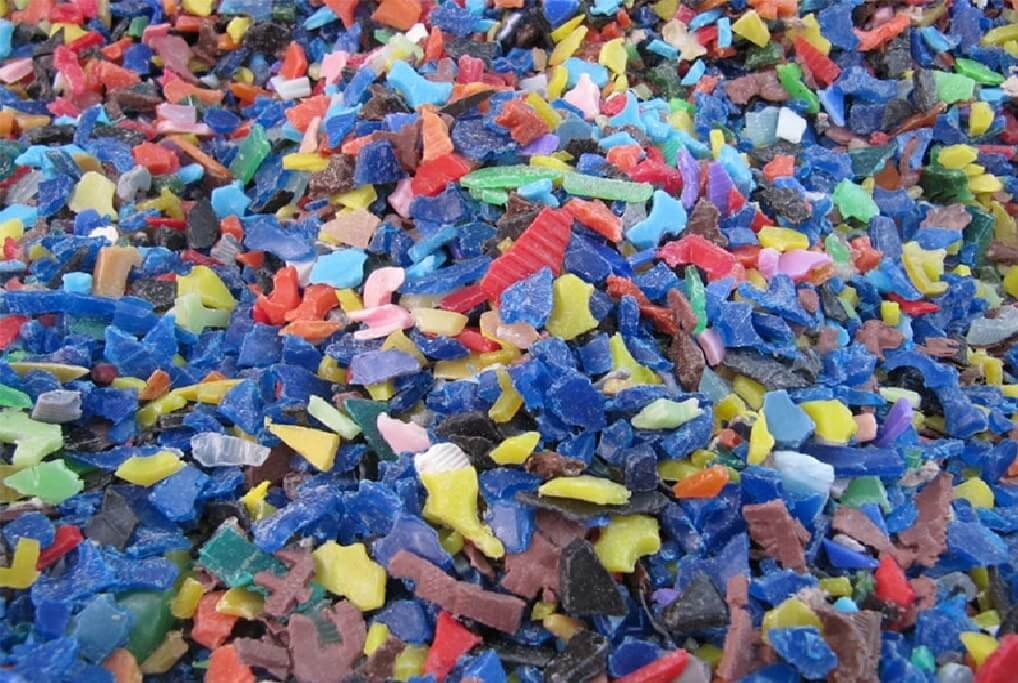

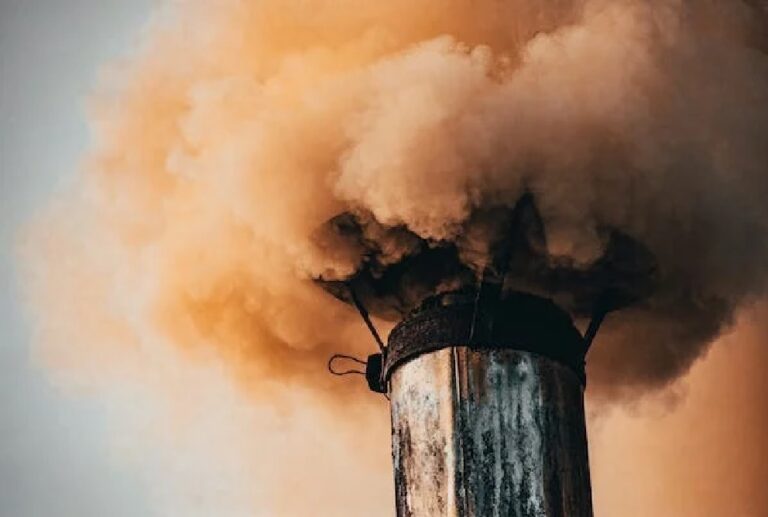
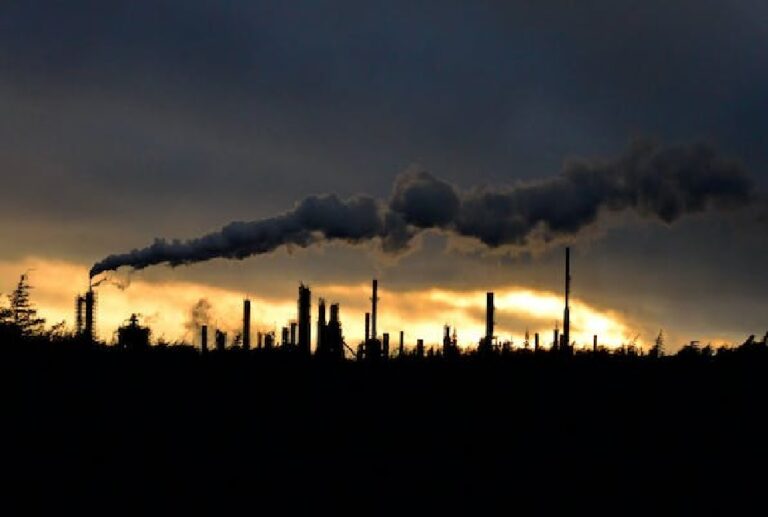
[…] to do with mountains of plastic waste? As a solution to the problem, it is proposed to introduce the most advanced and efficient […]
[…] to do with mountains of plastic waste? One such method is pyrolysis. Plastic Pyrolysis refers to the process of plastic decomposition […]
[…] Pollution: Many single-use plastics end up in oceans, where they harm marine life, break down into microplastics, and disrupt […]
[…] it Matters: Single-use plastics, such as disposable cutlery, straws, and plastic bags, contribute to plastic pollution in oceans and harm marine life. These items take centuries to decompose and pose a severe […]
Your site visitors, especially me appreciate the time and effort you have spent to put this information together. Here is my website ZQ3 for something more enlightening posts about Podcasting.
I like the comprehensive information you provide in your blog. The topic is kinda complex but I’d have to say you nailed it! Look into my page QU5 for content about Airport Transfer.
Wow, this post has given me useful info and answered some of my questions. I hope to give something back and aid others like you helped me. Feel free to surf my website ZH5 about Cosmetic Treatment.